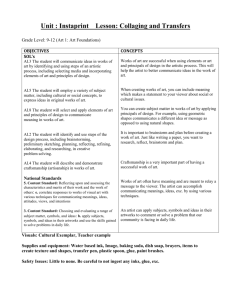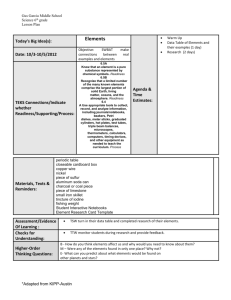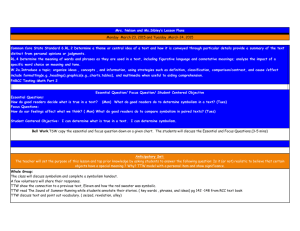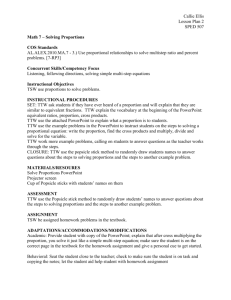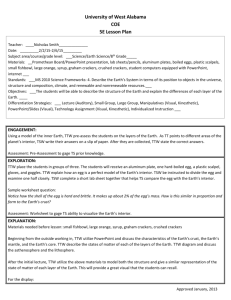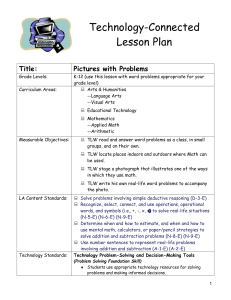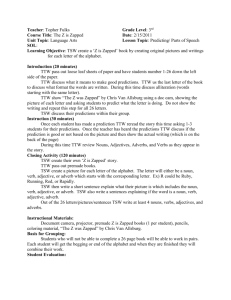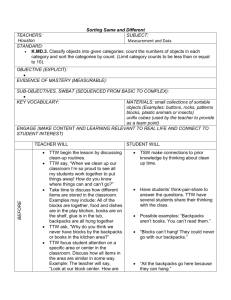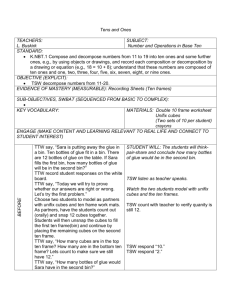Day5ScienceLPWaterCycle1
advertisement
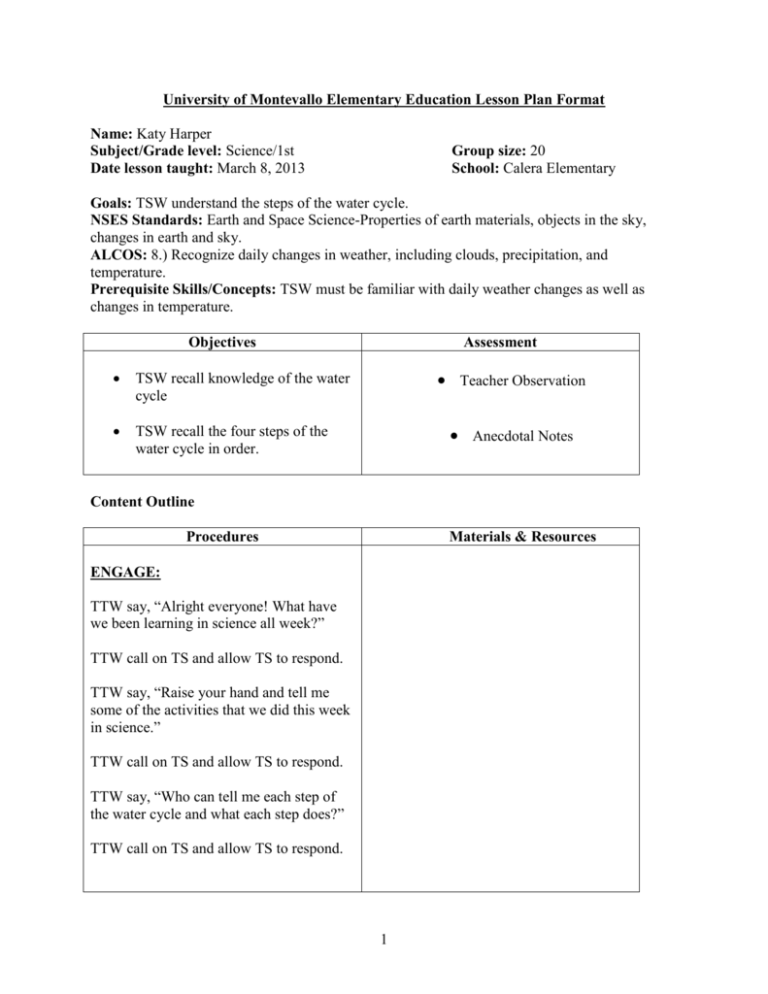
University of Montevallo Elementary Education Lesson Plan Format Name: Katy Harper Subject/Grade level: Science/1st Date lesson taught: March 8, 2013 Group size: 20 School: Calera Elementary Goals: TSW understand the steps of the water cycle. NSES Standards: Earth and Space Science-Properties of earth materials, objects in the sky, changes in earth and sky. ALCOS: 8.) Recognize daily changes in weather, including clouds, precipitation, and temperature. Prerequisite Skills/Concepts: TSW must be familiar with daily weather changes as well as changes in temperature. Objectives TSW recall knowledge of the water cycle TSW recall the four steps of the water cycle in order. Assessment Teacher Observation Anecdotal Notes Content Outline Procedures Materials & Resources ENGAGE: TTW say, “Alright everyone! What have we been learning in science all week?” TTW call on TS and allow TS to respond. TTW say, “Raise your hand and tell me some of the activities that we did this week in science.” TTW call on TS and allow TS to respond. TTW say, “Who can tell me each step of the water cycle and what each step does?” TTW call on TS and allow TS to respond. 1 TTW say, “Does the water cycle ever end?” TTW call on TS and allow TS to respond. PURPOSE OF LESSON: TTW say, “We are going to make Water Cycle Bracelets today, and you will get to wear them and take them home These bracelets are for both boys and girls to wear!” EXPLORE: TTW say, “Each bead on our bracelets will represent part of the water cycle. Look at the worksheet on the board. Each of you will get one of these worksheets, and then you will take your scissors and cut along the dotted lines to cut out the words. We will glue these words beside the color.” TTW say, “Light blue beads will represent precipitation. Green beads will represent grass. Dark blue beads will represent accumulation. Yellow beads represent the sun. Clear beads will represent evaporation. White beads will represent clouds. We have to make sure that we put these on our strings in a specific order.” Water Cycle Bracelet Worksheet Timer TTW have a student pass out the water cycle worksheet. TTW say, “Now, quickly cut out the words at the bottom of the page. Do not glue anything on yet. We will glue the words on there together. You have two minutes to do this.” Scissors Glue After time is up, TTW say, “Get out your glue sticks. Let’s glue the words “Sun shines” beside yellow. Lets glue the words “water collects on land” next to dark blue to represent accumulation. Then, we’ll glue 2 “water vapor rises/evaporation’ next to the word clear. Next, we will glue the words “clouds form/ condensation” beside white. Find the words “rain falls/precipitation” and glue them next to light blue. Then glue the words “on water” next to green. String TTW say, “In a minute, I will come by and give you a piece of string.” TTW hand out the pieces of string. Yellow, Dark Blue, Clear, White, Light Blue, and Green Beads TTW say, “I am going to give you each some different colored beads. You are going to put your colored beads on the string in the same order they are in on your paper. When you are finished, you may raise your hand and I will walk around and tie it on your wrist.” TTW set the timer, walk around and direct students to stay on task. EXPLAIN: TTW say, “Now that we’ve made our water cycle bracelets, you can explain to everyone how the water cycle works!” TTW say, “Raise your hand and tell me what the sun has to do with evaporation.’ TTW allow TS to respond. TTW say, “Why is it important for water to collect on the ground?” TTW say, “Very good! Now sit in your seat quietly. We are about to do something else to let you better understand how the water cycle works. EXTEND: TTW say, “I am going to give you a word search about the water cycle. This will help 3 you remember the scientific words about the water cycle. You will read the word at the bottom and then look for it in the letters. Circle the word when you’ve found it.” TTW say, “What type of words do you think will be in our water cycle word search?” Water Cycle Word Search (20) TTW allow TS to respond. Timer TTW distribute word search. TTW say, “You need to do this independently. If you can’t find a word, skip it and then go back to it later. You have about 10 minutes to do this.” EVALUATE: TTW walk around the classroom and observe TS as they work on their word searches. TTW take anecdotal notes to see if they are properly following directions. Conclusion: TTW say, “Today, we reviewed the water cycle by making our water cycle bracelets. You can look at these bracelets to help you remember the steps of the water cycle. You all did a great job today!” Accommodations: ESL students will be allowed to use GOOGLE translate for help understanding the material. Students with visual impairments will be allowed to sit closest to the board. Modifications: According to individual student IEP. Extensions: Students may get out their writing journals and write a friendly letter to a friend explaining the water cycle. They must list the four steps and explain what each step does. 4 References LanternFish ESL. (2006). Water cycle worksheets. Retrieved from http://bogglesworldesl.com/watercycle_worksheets.htm. McMurray, M. (2012, May 17). [Web log message]. Retrieved from http://fisforfirstgrade.blogspot.com/2012/05/water-cycle.html. 5
